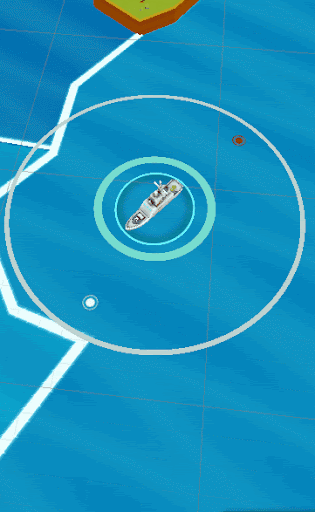BlueScan
2021
Real time tactical mobile game
Intentions :
Complementarity - Informative - Immersive
Pitch :
BlueScan is a game made for the Thales company where you are in control of two different naval forces to prevent a submarine from succeeding its missions in the open sea. The game will make you discover anti-submarine warfare and show you the utility of various Thales equipment.
My roles
3C Designer
Prototyper
Technical Game Designer
Unity - GitKraken - Jira
Context

As a follow up project of the card game we did a few months earlier, this game had similar goals, the main difference was the support. A mobile game allowed us to show the antisubmarine warfare much more freely. We had a lot of constraints nonetheless from the client : Thales. This time we had artists so we were able to organize the group of 20 people in three parts : Design, Programming And Art. Each person had their precise role for the development.
Development
Thanks to the knowledge we gained from the card game, we were able to start quickly even if we started on a truly different kind of game. We focused on a single player experience since we wanted the player to discover the new concepts at his own pace.
We started prototyping very early. We made a lot of iteration thanks to the different issues we discovered with the prototypes. On top of our iterations, we shared our progress with the contact at the Thales company, which gave us feedback and directives to follow.
Those constraints were not easy to implement in the existing games mechanics so we had to make compromises to satisfy the client while keeping what we thought was essential for the game to be fun.
The game evolved a lot during the development and big decisions had to be made in order to have a finished game before the deadline.
My work
My role changed throughout the development a few times depending on the needs of the project. I started by designing the core gameplay with the other game designers and then I was in charge of making various prototypes to validate (or not) our ideas. During this period, I discovered the impact of the gameplay programmers on the design choices. I had to make a lot of arbitrary choices (like the movement speed of the ship) while prototyping which didn't fit my idea of team work. So I encouraged other designers to manipulate those values and test them in the editor by themselves. This helped us to choose the best options compared to each person's representation of the game, and particularly the pace of the game.
I made some tools in Unity to help the production of the game. I also helped on the technical side during the production by coding some features or assisting other programmers.
During all the development, I helped to keep a good communication between the game designers and the programmers since I participated in meetings in both groups.
Conclusion
With this project I learned the impact of early prototypes and how to diminish their effect.
This project taught me to always be aware of communication gaps in a big team. I also had the opportunity to work for a big company with a precise order which taught me how to handle unexpected complications during production.
Other team members

Game Design :
Paul PARET - Creative lead
Côme RICHETTA - level designer
Manon GHIGNONI
Luc VIDAL
Thibaut LE DOARÉ
Game Art :
Samuel LAURO - art director
Aliénor TIGNON - lead tech art
Solène KRAWCZYK - tech artist
Chloé PLUMEY - 2D/3D artist
Lisa FOLLET - UI artist
Paul CONTI - Vehicle artist
Game Prog :
Rémi SÉCHER - lead dev
Thomas DEPRAZ-DEPLAND
Arthur DELEYE
Antoine LEROUX
Producing :
Simon PICARDAT
Théodore LABYT
Sound Design :
Mathieu VAN CAPELLEN
